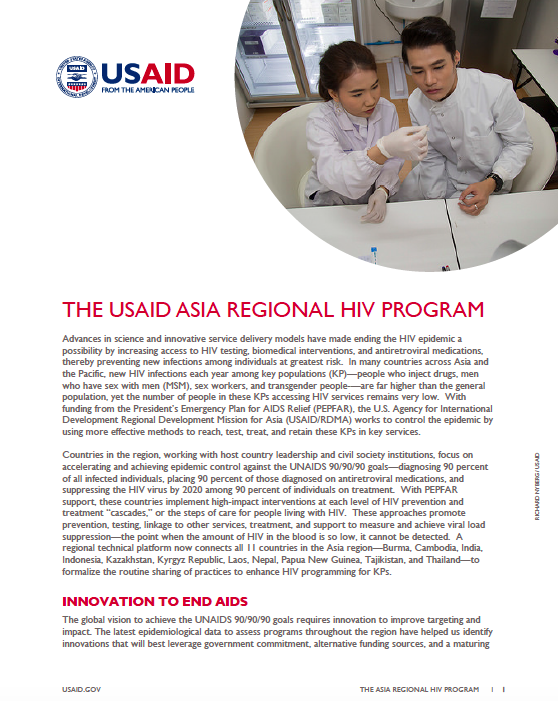Speeches Shim
Advances in science and innovative service delivery models have made it possible to end the AIDS epidemic by increasing access to HIV testing and antiretroviral medications, thereby preventing new infections among individuals at greatest risk. In many countries across Asia and the Pacific, the highest proportion of new HIV infections each year occurs among transgender women and men who have sex with men (MSM), yet the number of people in these populations accessing HIV services remains very low. With funding from the U.S. President’s Emergency Plan for AIDS Relief (PEPFAR), the U.S. Agency for International Development Regional Development Mission for Asia (USAID/RDMA) works to control the epidemic by using more effective methods to reach, test, treat and retain MSM and transgender women in clinical services. The PEPFAR Incentive Fund to Thailand has facilitated increased domestic financing to community-based services, forging stronger partnerships in the HIV response between the Royal Thai Government and civil society institutions. This has also supported a regional technical platform for connecting and sharing practices with other countries to enhance HIV programming for key populations.
INNOVATION TO END AIDS
The global vision to end AIDS involves diagnosing 90 percent of all infected individuals, placing 90 percent of those diagnosed on antiretroviral medications, and suppressing the HIV virus to undetectable levels among 90 percent of individuals on treatment by 2020. To achieve this vision, innovative approaches are needed to reach and retain in clinical services individuals with the greatest infection risks. Through partnerships with beneficiary-led, community-based organizations and public-sector service providers, USAID/RDMA supports convenient HIV testing, access to pre-exposure prophylaxis (PrEP) to prevent HIV acquisition and strengthens referral networks so that people living with HIV can initiate treatment early and stay engaged in care. The program is using social media and mobile technology to increase demand for lifesaving HIV services and has also helped providers become more efficient in reaching and retaining clients.
EVIDENCE TO GUIDE ACTION
To scale up innovative service solutions, the regional HIV program supports research activities through local and regional partners. Current evaluations focus on the effectiveness and efficiency of strategies to provide immediate HIV treatment to all HIV infected individuals, to expand access to PrEP and HIV and Hepatitis C testing through community-delivered models, and to provide more relevant, accessible and sustainable clinical services to those who are among the most marginalized members of society.
LOCAL CAPACITY FOR SUSTAINED ACHIEVEMENT
The regional HIV program works to enhance national HIV responses through civil society engagement in policy advocacy, capacity building of local partners and supporting collaboration among local and international stakeholders to generate more effective policies and programs to end AIDS. In Thailand, local partners advance the leadership and sustainability of community-based organizations providing quality HIV services to those most in need, accelerating desired health outcomes with a model that is nationally and globally recognized.
PARTNERS
USAID/RDMA coordinates closely with the U.S. Centers for Disease Control and Prevention to help countries identify, evaluate, adopt and implement more effective and cost-efficient solutions to address HIV and AIDS. The program implements core activities in Thailand and Laos through specific partnerships with:
- The USAID Linkages Across the Continuum of HIV Services for Key Populations Affected by HIV project, implemented by FHI360;
- The USAID Community Partnership project, implemented by the Thai Red Cross AIDS Research Centre; and
- At the regional level, the program convenes dialogue on innovations to optimize HIV services and ensure their sustainability.


Comment
Make a general inquiry or suggest an improvement.